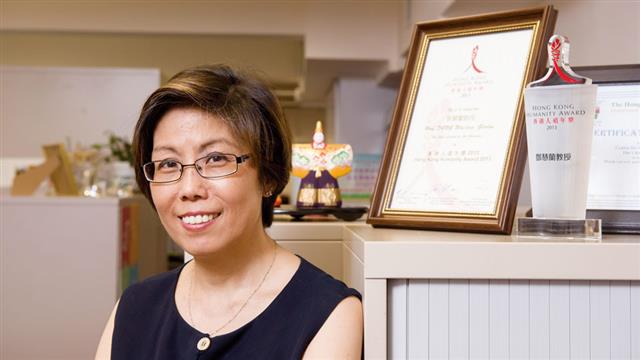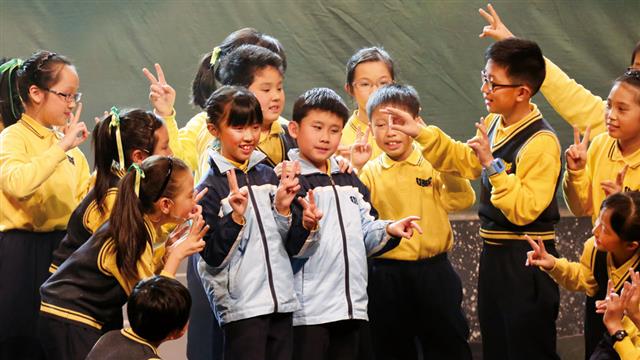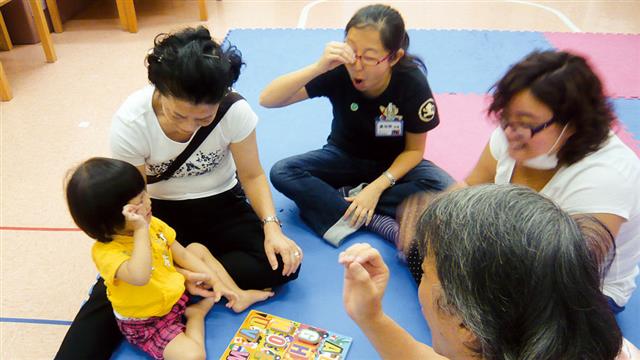Prof. Gladys Tang, director of the Centre for Sign Linguistics and Deaf Studies (CSLDS) at CUHK, said, 'I began sign linguistics research in the mid-1990s. Many deaf people I knew couldn’t write or speak in either English or Chinese. I was shocked. Why is this the case? Do the deaf have no language? Actually they do have, but it’s sign language, which due to a number of reasons, was never given the same importance as spoken languages. Hence those people never managed to develop their oral expression through sign language.'
Below are the myths that explain why deaf people usually have problems in speaking and reading though they have a voice and they can see:
Myth: Deaf people are mute.
Fact: The deaf may resemble the mute because they lack appropriate speech training, or they never receive sufficient linguistic input that enables them to speak.
Myth: All deaf people know sign language.
Fact: If sign language is not preferred as a medium of communication in education for the deaf, deaf people will have fewer chances to learn and understand it. Now many deaf students studying in mainstream schools don’t know sign language, or even despise it. They think they shouldn’t learn sign language.
Myth: Encouraging the hearing impaired to express themselves orally can promote social inclusion.
Fact: In Milan 1880, at the Second International Congress on the Education of the Deaf (ICED), it was decided to abandon using sign language and hiring deaf teachers in the education of deaf people. The rationale was that the use and acquisition of oral language promoted the inclusion of the hearing impaired into society. Though well-intentioned, the goal was elusive because congenital hearing impairment prevented students from receiving adequate linguistic input, which resulted in poor language skills, bad academic performance, erosion of self-confidence and failure of social inclusion. In 2010 in Vancouver, the 21st ICED apologized to all deaf people at the opening ceremony that the decision made 130 years ago was wrong.
Myth: Sign language will weaken other language abilities.
Fact: Research shows that deaf students under the Jockey Club Sign Bilingualism and Co-enrolment in Deaf Education Programme (JC-SLCO programme) were progressing in three aspects: Hong Kong sign language, oral language and written language. The three languages are positively correlated, i.e., if their sign language was good, their oral and written languages were also good.
Myth: Sign language is universal.
Fact: Different countries and deaf communities have their own sign language. Each has a different set of vocabulary and means of expression tailored to their needs. (source: Hong Kong Sign Language: a Trilingual Dictionary with Linguistic Descriptions)
Myth: Sign language comprises hand gestures and cannot express complicated concepts and feelings.
Fact: Sign linguistics began to develop in the 1960s. According to linguistic analysis, sign language is a natural language different from oral and written languages. Words are uttered one by one in oral language, but sign language can combine multiple concepts and show them with one gesture. Sign language is grammatically and structurally complete, and it is a well-developed tool for expressing thoughts as well as emotions.
A Humanity Awardee’s Tribute to the Deaf Community
While constructing roads can help remote villages connect with the outside world, building roads of a different kind can help the deaf to broaden their vision and stay in tune with the hearing population. For over 10 years, Prof. Gladys Tang has devoted herself to linguistics, sign bilingualism and inclusive education research, in short, everything to make life more pleasant for the deaf members of our society. She was presented the Hong Kong Humanity Award 2013 by the Hong Kong Red Cross and Radio Television Hong Kong in May in recognition of her efforts at enlivening and putting into practice the spirit of humanity.
Professor Tang said, ‘It is my hope that the Hong Kong Humanity Award will raise society’s awareness that language, whether signed or spoken, will have an effect on the personal development and cultivation of self-value of the hearing impaired.’ While there are increasing sign language and oral language services offered, tertiary institutions in Hong Kong may work together to identify affirmative measures that support the deaf to receive higher education.
Professor Tang’s path of academic research and her launch of the Jockey Club Sign Bilingualism and Co-enrolment in Deaf Education Programme seven years ago are marked by fearlessness and courage. When she first started that new teaching model in mainstream education, she was anxious because theories were her only support. Nevertheless, she went ahead. ‘Deaf students’ problem lies in not having an effective means for communication. If we bridge these gaps, they will be able to learn.’
A Happy School
After a couple of years, the programme bore encouraging results. ‘Students are happy and full of confidence. Parents are grateful and see the school as the future of deaf education. Deaf students are taught sign language which helps them to acquire knowledge effectively. They also learn how to speak, which enables them to communicate with others. For those who can’t speak well, they can use pen and paper since they are taught how to write well. Hearing parents are thankful because their children learn sign language and how to be caring. Now, when the school makes announcements on the loud speakers on campus, hearing students would proactively come out and sign for their deaf classmates,’ Professor Tang said.
Using Sign Language and Oral Expression
The ratio of deaf and hearing students determines the success of an inclusive education. ‘A mainstream school is dominated by oral language. The number of deaf students must reach a critical mass before enough sign language is produced to create a bilingual environment of signed and oral languages in which students can immerse themselves,’ she explained. Sponsored by the Hong Kong Jockey Club (HKJC), the JC-SLCO programme has been launched in phases at Kowloon Bay St. John the Baptist Catholic Primary School and Peace Evangelical Centre Kindergarten (Ngau Tau Kok) since 2006. A class of each grade will take about six deaf students. At present, the two schools have 11 and 37 deaf students, respectively. Classes are taught by two teachers—one hearing, one deaf. The teachers, who are equal in status, prepare course materials and teach using both sign language and oral expression.
A Win-Win Model
The merit of a bilingual classroom is that signed and spoken languages can complement each other. Professor Tang said, for example, ‘General studies is the most difficult subject for deaf students because they can’t understand verbal explanation on its own. But if there is a deaf teacher complementing this with sign language, they will find it much easier to grasp the content. At times when hearing students have missed something, their eyes will naturally turn to the deaf teacher.’ She recounted other benefits. ‘At first, we were more interested in learning about the bilingual development of deaf students. But later, we discovered that this model does not just benefit the deaf, but also the hearing whose sign language skills have improved, enabling them to become bilingual. I think this is a win-win situation.’
Apart from gaining better language skills, the academic performances of deaf students have been satisfactory. Recently, the Hong Kong Society for the Deaf surveyed over 100 parents with children studying in mainstream schools about the pass rate in Chinese, English and mathematics subjects. Only 50 to 60% managed to pass all three. The pass rate of deaf students on the JC-SLCO programme, by contrast, is 80 to 90%.
Baby Signing Class
The early childhood years are a crucial time for language acquisition. Professor Tang suggests parents to capitalize on this. ‘Some parents think sign language is easy and they can wait till their children have shown serious problems in linguistic development before letting them learn. But they may have passed the crucial age for language acquisition. Though hearing aids and cochlea implants can improve hearing ability, they can’t solve all the problems. If we can teach deaf children two languages from the very beginning, they can develop more healthily. Our partner school Peace Evangelical Centre Kindergarten (Ngau Tau Kok) provides such bilingual education to toddlers and prepare them for primary school. Our centre also offers baby signing classes. Currently 25 parents bring their children to learn sign language, enabling them to absorb linguistic messages in a barrier-free environment.’
What’s Next
The JC-SLCO programme will end in July 2014 after the eight-year sponsorship by the HKJC expires. Encouragingly for Professor Tang, both schools are willing to help seek resources and continue on this path of integration. She hopes that they will find the support needed to enable students to develop more comprehensively.
In July, the JC-SLCO programme will welcome its first batch of Primary Six graduates who are deaf. A mainstream secondary school in Ma Tau Wai, Notre Dame College, has agreed to partner with CUHK to implement the sign bilingualism model for another six years. This autumn, six graduates of St. John the Baptist School will go to Notre Dame College. Some of their hearing classmates have also applied to the school. Professor Tang thanked the Lee Hysan Foundation for their generous support in developing inclusive education in the secondary school. For the primary school programme, the CSLDS will join hands in raising funds with the schools. Professor Tang also hopes that the programme will receive the government sponsorship required for developing on a much fuller scale.
Honour and Recognition
The JC-SLCO programme has been added to the database of good practices for inclusive education by the UNESCO International Bureau of Education and the Gulf Arab States Educational Research Centre to provide policy-makers, schools, teachers, and other stakeholders with concrete evidence and relevant examples of inclusive education. In Hong Kong, starting last year, the Child Assessment Centre under the Department of Health will introduce parents with deaf children to the JC-SLCO programme, especially those whose toddlers are confirmed to suffer from hearing impairment. This allows them to develop mastery of both oral expression and sign language concurrently when they are at a crucial age for language acquisition.
The Road Ahead
Though her programme seems to be going very well, Professor Tang has one nagging worry about the future of deaf students. ‘At present, many excellent deaf students can only undergo vocational training to acquire skills such as giving manicures and hairdressing. Going to university seems not to be a viable option. In six years, we will have a batch of secondary school graduates, both deaf and hearing, who are good at both signed and oral languages, and who can write well, applying to universities. I believe the hearing-impaired should also be eligible to enter university. Yet would they receive effective support in a university? There are many obstacles I still need to tackle.’





